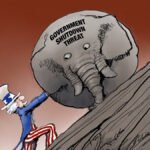The Generation, Year: 1, Issue: 12
On 14 November, remarkably, the US Bureau of Labor Statistics announced that the consumer price index was unchanged in October. To be clear, that means the level of the CPI was unchanged; its rate of growth, or inflation, was actually zero. Of course, one month doesn’t mean much. Gasoline prices won’t plunge by 5% every month, as they did between September and October. But there are also more promising – and meaningful – longer-term data available: the headline CPI inflation rate over the last 12 months was 3.2%, far below the 6.5% average in 2022. At the risk of tempting fate, one might say that the inflation battle is being won.
Contrary to the predictions of many economists – and the enduring perception of many Americans – the US inflation rate has, so far, come down without a major decline in economic activity or employment. In fact, the economy has added an average of 204,000 jobs a month over the last three months, well above the labour force’s long-term growth trajectory. As a result, unemployment remains under 4%, almost the lowest level since the late 1960s. Meanwhile, annualised GDP growth amounts to 2.3% so far this year, faster than the average rate since the turn of the century.
The story in other developed economies is similar, with inflation rising in 2021-22 and then falling, though their performance lags behind that of the US. Canada, the eurozone, Japan, and the UK/are all growing more slowly than the US, and inflation in Europe has not fallen as much as it has across the Atlantic. Inflation remains very low in Japan.
According to the traditional rules of politics, the US Federal Reserve and President Joe Biden’s administration should get credit for America’s relatively painless bout with inflation, regardless of whether their past policies helped create it. But do they really deserve it?
It seems clear that, two years ago, US policymakers underestimated inflation risks. Moreover, interest rate hikes did not rein in inflation through the usual causal route – that is, by driving down output and employment. But that does not mean that raising rates made no difference. There are other transmission mechanisms between interest rates and inflation, including the housing market, the exchange rate, and commodity prices. Mortgage interest rates, which help determine the demand for housing, have risen sharply over the last two years, as the Fed ended quantitative easing and tightened monetary policy. Furthermore, the US dollar’s effective exchange rate has appreciated more than 8% against other major currencies since March 2022, when the Fed began to raise interest rates, though admittedly currency appreciation does less to dampen tradable-goods prices in the US than elsewhere.
Then there are the prices of commodities, such as oil, minerals, and agricultural products. From March 2022 to October 2023, the global price index for all commodities fell more than 30% in dollar terms – a predictable outcome, given that high interest rates put downward pressure on these prices.
But none of these developments explains why the disinflation has been accompanied by so little loss in economic activity. What could explain this phenomenon is the proposition that the Phillips curve becomes much steeper when an economy is close to full employment. With unemployment below 4%, and job vacancies running above 7%, any decrease in aggregate demand is translated almost entirely into lower inflation, rather than into lower economic activity.
But there might be a better explanation: supply chain disruptions, which were formidable in 2020-22, melted away in 2023. The Covid-19 pandemic led to clogged ports, order backlogs, input bottlenecks, labour shortages, and other supply issues. But according to the Global Supply Chain Pressure Index, produced by the Federal Reserve Bank of New York, such disruptions peaked in December 2021, and have been declining steadily since April 2022. It seems that the “invisible hand” of the market, which had gone missing during the pandemic, has returned to its normal task of encouraging the economy’s smooth functioning.
A favourable shift in the aggregate supply relationship should allow for lower inflation at any given rate of economic growth. The question is why this shift resulted in lower inflation, rather than higher GDP growth. (Since last year, US growth has eased down from the levels recorded in 2021, when the economy was overheating – the soft landing for which we were all hoping.)
The answer may well lie in monetary tightening. If the Fed hadn’t raised interest rates after March 2022, the US economy probably would have continued to overheat, regardless of the favourable supply shift, and inflation would still be high today.
Let’s give credit where credit is due. The Fed deserves a fair share of it.
Source: The Gurdian







